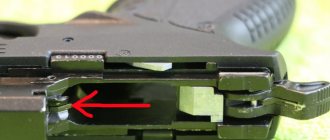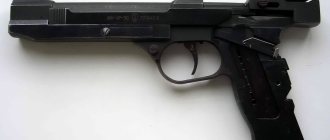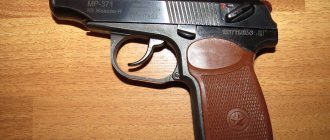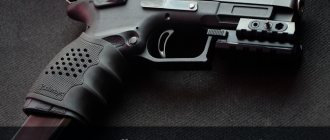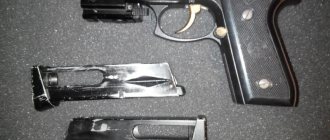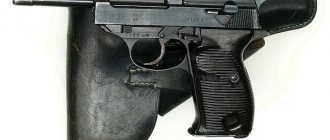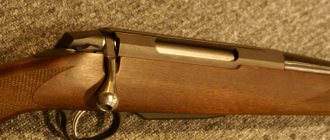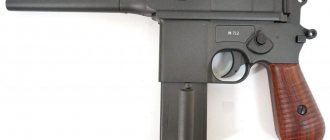Sports shooting has always been a distinct discipline, requiring the shooter to comply with certain rules and standards. However, when it comes to weapons intended for competitions and training, everyone usually forgets about any specifics. We will try to understand what a sports pistol is, as well as what distinctive features such a weapon has.
Features of sporting weapons
Before you begin to understand the question of what a sports air pistol is, it is recommended that you first learn about the main features of such weapons. It is usually customary to talk about four nuances:
- Availability of a license. To purchase a sports pistol or rifle, you must have a special license to carry and use such weapons (we will talk about how to obtain this document later). You won't be able to buy the model without it.
- Barrel type. There is a very important rule in sports shooting: only those athletes who own an air gun with a rifled barrel are allowed to compete. The use of smooth-bore models is for hunters.
- Specifications. Each sports pistol or rifle has certain indicators of power, mass and bullet speed. These values must not exceed those established by the international sports association.
- Design features. Sports weapons have a certain device, for example, a biathlon lever, a diopter sight or a breaking cocking mechanism. At the same time, some parts of the design are prohibited (choke tubes, optics).
However, these are only general features that are characteristic of sporting weapons in general. Do not forget that the requirements can change dramatically depending on the type of “instrument”, as well as the type of competition. For example, biathletes cannot use rifles with a standard stock, but are forced to purchase models with a bullpup, but those who participate in regular sports shooting have no such restrictions.
It is also important to understand that sporting weapons have a narrow specialization, which means they have a certain set of advantages and disadvantages. Before purchasing this or that model, it is recommended to carefully study the small block:
| Advantages | Flaws |
| Accuracy (sports pistols and rifles have good accuracy) | The need for frequent reloading (the main disadvantage of sports pneumatics is the lack of automation) |
| Balancing (in sports models the trigger is positioned so that the weapon has a good center of gravity) | Bullet speed and shot power (indicators are too low to use the weapon for purposes other than sport) |
| Availability of idle trigger (most sports models have the ability to simulate a shot, which is useful during training) | High percentage of air bleed (if you loaded a sports pistol, shoot, otherwise it will begin to lose its power) |
| The ability to independently replace parts (sports pneumatics are easy to modify) | The design of the weapon is not suitable for beginners, especially when it comes to professional weapons |
Of course, no one says that sports pneumatics must necessarily be used for performance in competitions. However, if the potential buyer does not pursue such goals, then it would be better to choose another type of weapon, for example, a hunting or recreational one.
About documents
It should be remembered that rifled weapons for sport shooting can only be purchased if you have the appropriate documents. This is required by law. It limits the circle of people who have the right to bear arms. Short-barreled rifled weapons for sport shooting (pistols) also fall into this category. To purchase it (both short-barreled and long-barreled) you will need to submit documents. The papers must indicate that the buyer is a high-class athlete with a certificate for the sport in which the weapon will be used. Also, those who previously owned smooth-bore firearms have the opportunity to purchase.
Requirements for sports air pistols
Now it’s time to talk about what requirements a pistol must meet in order to be called a sports pistol. As mentioned earlier, a lot depends on the type of sporting event at which the weapon is planned to be used. However, there are several important points that any sports pistol must meet:
- type of impact mechanism - compensated or spring;
- initial bullet speed – no more than 120 m/s (but not less than 90 m/s);
- muzzle energy indicator (up to 7.5 J);
- caliber of ammunition used - 4.5 millimeters;
- barrel type – rifled (with at least 1 groove per centimeter);
- release type - with pre-cocking (no more than 500 grams);
- Dimensions – no more than 420 mm in length, 200 mm in height and 50 mm in width;
- material – metal, wood, rubber (plastic guns are not allowed everywhere);
- fuses - automatic or mechanical.
Another important point of admission to competitions is the absence of third-party modifications on the pistol. And we are talking not only about the “body kit” that gives the shooter an advantage or affects the technical characteristics of the model.
Very often, athletes are not allowed to compete simply because they install an additional choke on their pistol or cut the barrel. None of the judges will test the pistol to determine whether it meets the standards not only according to the passport, but also in reality.
Choosing an air pistol for sport shooting
Choosing a pistol for sport shooting is not such a simple task as it might seem at first glance. After all, such a weapon must not only meet established standards, but also suit the individual preferences of the potential buyer. In this regard, we recommend paying special attention to 4 nuances: the type of sight, the shape of the handle, the weight of the weapon, as well as its behavior when shooting. The following sections provide more detailed information on each item.
Types of sights
In most cases, only those pistols that have a standard sighting device in the form of a front sight and rear sight can be used in standard sports disciplines. Sometimes shooting competitions may be held with a collimator or diopter sight. However, in order to be sure of being allowed to compete, it is best to play it safe and choose a pistol whose sighting device meets the following requirements:
- The rear sight and front sight are made of metal, not plastic. This not only gives you permission to compete, but also guarantees the pistol’s resistance to mechanical damage.
- Presence of rigid aiming adjustment. Usually it is carried out using two drums located on the rear sight: one adjusts the vertical, the other – the horizontal.
- A fixed and rigidly mounted front sight, not protected by a safety ring, which in most cases only interferes with aiming.
To be fair, almost all air pistols meet these requirements. The only exceptions may be weapons intended for airsoft, as well as cheap models that do not have the ability to adjust the sight. It is not recommended to purchase such samples, since sports shooting involves constant adjustment of the shot.
Handle shape
One of the main features by which you can distinguish an amateur pistol from a sports pistol is the presence of an automatic grip, which ideally fits the shooter’s hand (like the Tula Tokorev or Makarov pistol). It is also highly recommended to choose a model that has the ability to adjust this part, because after the first shots a person will begin to understand in which case it would be more convenient for him to hold the weapon. Individual adjustment can be achieved using special mechanisms or by completely replacing the handle.
In order not to make a mistake and buy a weapon that will be pleasant to hold in your hand, you should pay attention to training sports pistols with wooden equipment (IZH-53 or IZH-46). Such pistols can be distinguished by their non-standard appearance. However, instead of modern aesthetics, such models have the ability to adjust the pistol grip to the shooter’s hand. It is enough to use a special mechanism that adjusts the position of the wooden part down to the millimeter (incomplete disassembly of the gun will be required).
Weight
The weight of a sporting weapon is one of those nuances that many buyers forget about and then regret. There is no clause in international generally accepted standards that would address this point (only the rule on dimensions). However, this does not mean that for training and competitions it is worth buying a 2-kilogram gun, which will be impossible to hold in your hand. The preferred weight is from 1.2 to 1.3 kilograms for men and from 1 to 1.1 kilograms for women. Such weapons have an ideal balance between weight and recoil absorption from a shot (the greater the mass, the less inertia).
It is also worth noting that a pistol for training shooting should not differ too much in weight from the weapon that is planned to be used in competitions. Even having felt a difference of 200 grams, the shooter can already make a bunch of mistakes. And if for competitions an athlete is given a pistol that is half a kilo lighter than a training weapon, then the person will begin to feel completely insecure. At the moment of aiming, the front sight may begin to twitch strongly, because the hand is simply accustomed to a heavier weapon model.
Shooting behavior
Well, there is one last point that is worth remembering when choosing a sports pistol. Of course, few stores can allow their potential customers to try out the product at the shooting range. However, do not forget that any weapon can be returned within 2 weeks after purchase if you provide complete equipment (including box) and a receipt.
When giving a pistol a test drive, it is worth remembering that shooting should be done with one hand, and the athlete should stand half-sided to the target. For training, it is recommended to fire at least 20 shots from a distance of 10 meters. If the result is acceptable, this means that the weapon is well suited for future training and competition. If the scatter turns out to be too large, then it may be worth replacing the model with a more suitable one.
So how should an air sporting pistol behave when shooting? Here are a few points:
- the recoil of the weapon should not be too noticeable - if the pistol “kicks” all the time, then it will not be possible to avoid bruises on the palm;
- the weapon should not tilt forward or backward when aiming - this behavior indicates an unbalanced center of gravity;
- the front and rear sights should not interfere with the shooter’s ability to focus on the target - this is why fiber-optic threads are prohibited in competitions;
- When firing, a person should not feel how the bolts unscrew and parts become loose - signs of poor quality assembly.
If you do not pay attention to all these points in time, you can have time to replace the purchased model with a more suitable one, thereby increasing your chances of winning the competition.
Rating of the best models
Unfortunately, arms factories are quite reluctant to produce pneumatics intended exclusively for sports (the circle of potential buyers is too narrow). However, this does not mean that the athlete does not have the opportunity to run into purchasing a cheap and useless model. To prevent this from happening, we recommend paying attention to the 3 best sports pistols in the world, belonging to different price categories:
| Model | Short description | Price, rub |
| Crosman P1377 BR | One of the most popular models among all compression weapons. Let the buyer not be scared by the word “Taiwan” in the “manufacturer” column. The arms factory produces pistols under an American license, so the quality remains at the highest level. The model is very popular among novice athletes and people who want to improve their shooting skills. | 6500 |
| Baikal IZH -46 M (MP-46M) | Perhaps the best sports pistol from a Russian manufacturer, which was used back in the Soviet years. The modern modification is distinguished by improved technical and ergonomic characteristics, better assembly, and the presence of an adjustable sighting device. The pistol is suitable not only for beginners, but also for professional athletes. | 30 000 |
| Steyr Evo 10 Silver | Despite the prohibitive cost, the Austrian pistol is extremely in demand among professional athletes. The model is distinguished not only by its stylish design, but also by multi-compression - the gas cylinder is inflated by a built-in pump. The best and most expensive sports air pistol in the world. | 270 000 |
Manufacturers
The market leaders at the moment in this area are the Germans. The professional world is completely covered with rifles and pistols from Walther, Steyr and Feinwerkbau brands. We won’t look at them too much; we’ll support the domestic manufacturer, but I still recommend admiring these models.
Feinwerkbau 700 Alu
Walther LP400 Alu
